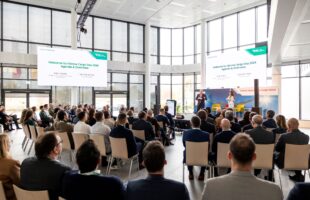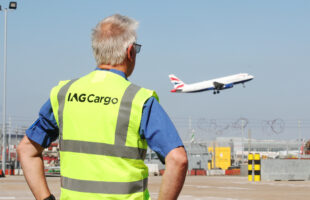With rapid growth taking the company from a an A$27 million (US$28.7 million) company in 1990 to a $10 billion company by 2006, its potential for growth in the Australian market was nearing its limit. Things changed dramatically for the home-grown company when the Australian competition authorities ruled its business was anti-competitive. The result saw the organisation splitting into two, with ports, stevedoring and its rail freight business being hived off. This development was in reality probably the best thing that could have happened for Toll as it set it on a new path that focused on its international business.
“This then left Toll in a position with a lot of cash on the balance sheet, a healthy profitable organisation but reasonably restricted in terms of further aggressive growth in the Australia/New Zealand market,” says Paul Coutts, group products marketing and sales director, Toll Global Forwarding.
This forced a rethink of the group’s strategy which under the leadership of CEO Paul Little who seeing the continual development of the supply chain coming from origin in China coming into Australia and Asia in general decided he would make the leap into Asia. The decision was made to create the infrastructure in Asia which would then ensure Toll would be further up the supply chain and more easily able to control the origin, as well as the destination for its customers.

Acquisition strategy
This then led to the acquisition in 2006 of Singapore-based SembCorp Logistics which gave the company its first foothold in the Asian market. Two years later the company acquired Hong Kong-based logistics company BALtrans and the die was cast.
“Once we acquired those businesses we very quickly realised that there was a fairly large amount of traffic coming out of Asia coming into markets in Europe and the US and we were being asked by a lot our customer base to expand our field of operations into those regions,” says Coutts.
This then was the impetus for further global merger and acquisition (M&A) activity for Toll Forwarding – which is aiming to boost global revenues from 2007’s $100 million and nearly $2 billion currently, to $3 billion by 2012/13.
This global M&A strategy continues to this very day and in fact saw only days earlier from the time of writing, the acquisition of German business ocean freight logistics company, Andree & Wilkerling (AWG). Prior to that Toll Global Forwarding has been on an acquisition roll over the past couple of years having acquired some eight companies around the globe including two in Dubai, one each in the UK, Australia, New Zealand and the US.
The US acquisition of Summit Logistics International, which included Summit’s domestic logistics division FMI, was significant as it marked its first foray into the North American market. FMI’s business mainly centres around the forwarding and contract logistics fulfilment for many of the major retailers in the US. Another key acquisition was that of German-owned, Dubai-based SAT Albatros which is the world’s leading sea-air forwarder.
Coutts says the strategy is to identify target organisations in local markets and local environments with a focus on the acquisition of “local heroes who have a capability beyond their local market.” He cites the example of UK-based WT SeaAir which although it had a strong presence in the UK, it also had offices in India, China and Hong Kong, “which therefore gave us opportunities for creating synergies with our business and that’s been the logic with every acquisition we’ve made.”
“We always look at the connectivity between the businesses we currently have and the business we could possibly acquire. Another important aspect for us is that we’re not acquiring for the sake of acquiring and getting bigger, we are looking to acquire competitors, or companies who can either add to our infrastructure, or fill our geographical white spots that we have, or indeed gives us new capabilities and infrastructure COVER STORY through the products they bring to the table or the skill source and abilities they bring to the table,” Coutts says.
In particular he notes there are white spots in Europe, particularly in some of the larger countries like Germany and also the Middle East. “We are already in Dubai so we want to expand that further in places like Bahrain and other parts of the United Arab Emirates.” He added that Toll Forwarding is also interested in further forays into the US market to complement the Summit and BALtrans business. The group is also interested in expanding its footprint to Latin America, he added. With coverage now provided through an agency operation in Brazil, Coutts said. “It would be fair to say that Brazil would be of significant interest.”
Where Toll does not have an ownedpresence it operates through agencies. “In the acquisition phase a lot of those companies had agents in various places – some of those agency relationships, like Spain for instance, we’ve had for more than 15 years and those agency relationships are really important for us and work well. So when we’re on this acquisition path we are sensitive to the agency relationship and we keep that in mind as we go through the process.”
Taking on the ‘big boys’
The group’s clear expansionist strategy provokes the obvious question as to whether Toll sees itself taking on the established Kingpins of the industry – the DHL’s, Schenkers and K+N’s of the world. “We don’t see ourselves as going head to head with a DHL or K+N or Schenker – we’re obviously going to come across those companies when we’re bidding for business, but we don’t really go head to head with them because we’re in a slightly different markets,” responds Coutts.
“Our focus is around mainly the retail sector and also the entertainment multimedia sector and we do have some business in the hi-tech sector but at this point in time its not something that would necessary encroach on the mass of hi-tech business that DHL would have, for instance.
Ours tends to be fairly niche in its approach. We’re not really in the same competitive environment. I think our competitive advantage is that the solutions we offer are very specialised they’re almost customised on a customer by customer basis. We are very agile and we have to be because the retail environment is extremely dynamic, extremely competitive and extremely fluid and you have to be able to move very quickly to capture the opportunities that are there,” he says.
One Toll
As part of a larger group that includes logistics and express divisions, among others, Toll Logistics leverages its counterparts depending on the client requirements. “Some of it is done by the logistics side and some of it is done purely within the forwarding arena,” Coutts adds. The criteria under which the forwarding side makes that decision is on a case-by-case basis he says, but ultimately it comes down to how long is the product actually going to sit in the warehouse environment and what the scope of work is within that warehouse environment.
If the scope of work is hugely complex and the product is going to sit within the warehouse for something like more than two weeks and it’s therefore a huge inventory control exercise than that’s contract logistics, he says. On the other hand, “if the product is going to sit in the warehouse for a short period of time and effectively it’s a cross dock operation with some inventory control and some pickand- pack operation and some labelling then we’ll do that within the forwarding environment because its more or less part of the same stream.”
He notes this is also the same situation in reverse with the Logistics division coming to the forwarding side for certain parts of their scope of work that they’ve got from their customers, because it may not fit well with their operation. Coutts himself is based in the Logistics offices in Singapore to help ensure that connection remains firm.
The Toll group is also actively expanding its Express division which until very recently has been predominantly Australia-based, but in the course of the last few years has acquired a couple of companies in Asia and is now focusing on building up its regional business.
“ We have common customers that we work with – customers that use us that also have an express need and they have customers that have a freight forwarding need, so we’re in constant communication with our express colleagues about these customers and how we’re going to serve them as a Toll group – what we call the One Toll Concept.”
The group also has a global resources group catering to the energy and mining sector and “we work very closely with them for the obvious reason that a lot of the companies they are dealing with are companies that require international forwarding on a project basis, companies like the Halliburtons of the world.”
Late comer?
The other intriguing questions is whether its relatively ‘late’ entry in the market is a boon or bane. For Coutts it’s clearly a plus factor. “It’s more of a plus than a negative and the reason I say that is because while we are relatively late on the scene, we’ve got a whole wealth of experience that we are bringing to the table here.” He points to the fact the group as a whole has done something like 112 acquisitions in the last 20 years and the majority of these he says have gone well. “So we’re reasonably good at acquisitions and integration and we’re very sensitive to the cultural considerations that you have to go through to get that done successfully.
“But we’re also experienced at taking those different companies and blending them and creating a network out of it and that’s effectively what we’re doing here – taking these companies that up until recently have been disparate organisations and blending them from fairly patchwork operations and creating that global network,” Coutts says. He credits much of this due to the expertise at Toll which is a vast combination of talent with experience in most of the big names of forwarding and logistics. Coutts himself has substantial experience working at DHL, for instance.
“We are basically taking people from best-in-class organisations and combining them with the strength, experience and skills that exists within the Toll group and also the within the companies we’re acquiring – so I think we’ve got a good blend of management experience.”
Customers appear to be happy with this newly emerging player with Coutts saying that feedback the group is getting from the US and Europe is that customers are ready for a new player, ready for somebody to come in with a slightly different approach to the ‘big guys’.
“We think we can bring something different to the table through a customised and agile approach. We also have the benefit that when you come late to this type of environment you know where the industry has come from and you know the errors other people have made and you can learn from them and not repeat them,” he says.
Asia business
And, like many carriers, forwarders and logistics companies, the intra-Asia business is growing faster than any other segment. “We’re certainly seeing very, very rapid growth on this tradelane,” Coutts says. While most of these volumes are driven by China into Singapore, Thailand, Malaysia, Indonesia and so on, India is also a growing segment and a market where the forwarding division has a dozen offices across the country.
“While China into India is a small percentage of the overall market, it’s definitely the fastest growing and we have to keep a very close eye on developments there.”
“I think we’re pretty well set up to capitalise not only in terms of the origin traffic out of Asia into the rest of the world, but also that intra-Asia piece which is vitally important,” he adds.
Vietnam, which has attracted growing attention because of the combination of the shift and diversification of manufacturers out of China, is also expanding very rapidly with Coutts noting it’s a good growth market for Toll. The forwarding division invested quite substantially in the country 2-3 years ago and Coutts says the division is happy with the returns it’s getting.
“I think we’ll continue to see it grow and grow probably even more aggressively in the next five to ten years. Also I wouldn’t ignore Cambodia as we think that’s going to become increasingly important and we think perhaps it’s going to be the next Vietnam of the future.”
He also notes that global manufacturers and the logistics industry as a whole is watching the China situation very closely in terms of the cost of labour and also the support costs around it – increasing health and safety issues and the associated costs. “Customers are looking around more and more as to where else they may be able to manufacture to try and make sure they’re getting the best option,” he says.
Indonesia is clearly one of those options and it’s a country Coutts describes as “somewhat of a sleeping giant” for a number of years. “We’ve always had very steady growth in Indonesia but it would be fair to say not the same kind of growth as in the some of the more dynamic markets, but we do think Indonesia still has huge potential, but the question is when is that really going to be realised.”
And with a substantial 68 per cent of its origin volume coming out of China and Hong Kong – like most of its counterparts – the vast potential of China will remain a focus for some time to come. The forwarding division has opened up a number of offices in the inner-west of the country in the last two years or so, in a large part due to the Chinese government’s move to encourage manufacturers to move inland away from the traditional coastal production centres.
“We are trying to march down the path of both what our customers strategies are and our own, in opening up new offices and new branches and we definitely think that will continue,” he says pointing to the “still amazing statistics coming out of China.”
Air and ocean
The other key area that the Forwarding division is looking at is the air/ocean segment. “To a great extent we’ve been a very strong ocean freight company with roughly about 65 per cent of our business from ocean freight, 35 from air freight. And that’s a huge opportunity for us because we are successful at ocean freight and we certainly want to grow it, but at same time we’ve invested very heavily in creating a global airfreight team and an airfreight infrastructure by putting a lot of block space agreements with airlines,” Coutts says.
“We now have a strategic airline carrier programme in place and our ambition and our goal is to change the balance a bit more in terms of ocean and air closer to 50-50 and we believe we’ve got a massive untapped potential within that ocean customer base because 90 per cent of those customers on the ocean side also use air freight.”
“The whole air/sea market is still relatively small and that’s the exciting thing,” he says noting that most of the volumes are out of Asia by ship into Dubai and then into Europe by air. The Forwarding division is now designing a strategy to take that product global, with a keen eye on Latin America and the US east coast and this potential market was a key driver behind the acquisition of Dubai-based SAT Albatros.
“A number of our competitors, the large guys, have tried it in the past and it’s never really gone very far,” he adds, saying that he believes Toll Forwarding can make it work because it has the advantage of being smaller, more niche and more agile.
Market conditions
Coutts says he believes the industry – both air and ocean – learned valuable lessons from the global financial meltdown. “I think we’re being a lot more responsible in terms of how we manage this temporary lull,” he notes of the current lethargic cargo environment. “We do think it will be temporary, it’s only a matter of time before it bounces back – whether it’s in 6, 12 or 18 months time, all of us are going to have to just sit tight and see what happens,” he says.
“I think there will be a peak, but the question will be how tall the peak will be.” He does note that on the ocean shipping side there has been a significant rise in activity in the last couple of months which is an encouraging sign as this is the start of the traditional ocean shipping peak season and may signal that air cargo will also experience its traditional November/December peak. “How long and how high the peak will go we don’t know, we just have to wait and see.”








